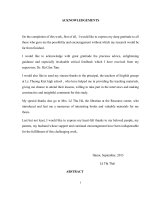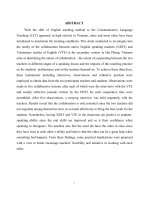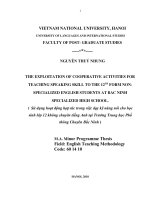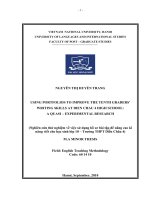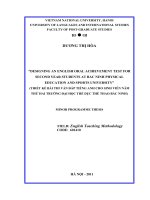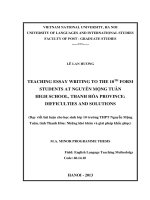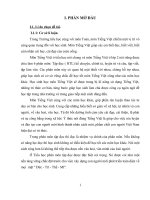Những khó khăn trong việc dạy kĩ năng nói cho học sinh lớp 10 trường THPT vân canh
Bạn đang xem bản rút gọn của tài liệu. Xem và tải ngay bản đầy đủ của tài liệu tại đây (1.68 MB, 65 trang )
1
VIETNAM NATIONAL UNIVERSITY, HANOI
UNIVERSITY OF LANGUAGES AND INTERNATIONAL STUDIES
FACULTY OF POST-GRADUATE STUDIES
NGUYỄN THỊ THÚY
DIFFICULTIES IN TEACHING ENGLISH
SPEAKING SKILLS TO THE TENTH FORM STUDENTS
AT VAN CANH HIGH SCHOOL
(Những khó khăn trong việc dạy kĩ năng nói cho học sinh lớp 10
trường THPT Vân Canh)
M.A. MINOR THESIS
Field :
English Teaching Methodology
Code :
601410
Hanoi, 2011
2
VIETNAM NATIONAL UNIVERSITY, HANOI
UNIVERSITY OF LANGUAGES AND INTERNATIONAL STUDIES
FACULTY OF POST-GRADUATE STUDIES
NGUYỄN THỊ THÚY
DIFFICULTIES IN TEACHING ENGLISH
SPEAKING SKILLS TO THE TENTH FORM STUDENTS
AT VAN CANH HIGH SCHOOL
(Những khó khăn trong việc dạy kĩ năng nói cho học sinh lớp 10
trường THPT Vân Canh)
M.A. MINOR THESIS
Field:
English Teaching Methodology
Code:
601410
Supervisor: Prof. Dr. Hoàng Văn Vân
6
LIST OF TABLES AND FIGURES
Table 1: Students‟ level of language learning ................................................................16
Table 2: Students‟ motivation for learning English ........................................................16
Table 3a: The frequency of using techniques .................................................................20
Table 3b: Students‟ opinions towards teachers‟ teaching speaking techniques .............21
Table 4: Students‟ difficulties in speaking lessons .........................................................22
Table 5: Factors affecting students‟ participating in English classroom activities .........23
Table 6: Students‟ expectation from the teachers ...........................................................23
Table 7: The teachers‟ age and their teaching experience ..............................................24
Table 8: Teachers‟ difficulties in teaching English speaking skills................................26
Table 9: Teachers‟ solutions to the problems .................................................................27
Table 10: Teachers‟ suggestions to overcome the difficulties ........................................28
Figure 1: Students‟ attitudes towards English speaking skills ........................................17
Figure 2: Students‟ opinions on the speaking topics in the textbooks ............................18
Figure 3: Frequency of students‟ speaking participation ................................................18
Figure 4: Opportunities to use English outside classroom .............................................19
Figure 5: Students‟ self-improvement of speaking skills ...............................................19
Figure 6: Teachers‟ attitude towards speaking skills ......................................................25
Figure 7: Teachers‟ techniques of teaching speaking skills ...........................................26
7
LIST OF ABBREVIATIONS
CLT: Communication Language Teaching
PW: pair work
GR: group work
I: interview
UP: using pictures
G: game
D: drama
De: debate
RP: role play
ST: story telling
P: presentation
N0 : number
%: percentage
8
TABLE OF CONTENTS
Declaration ........................................................................................................................ i
Acknowledgements .......................................................................................................... ii
Abstract ...................................................................................................................... …iii
List of tables and figures ................................................................................................. iv
List of abbreviations .........................................................................................................v
Table of contents ............................................................................................................. vi
Part A: Introduction ..........................................................................................................1
1. Rationale ...............................................................................................................1
2. Aims and significance of the study .......................................................................2
3. Scope of the study .................................................................................................2
4. Research questions ................................................................................................2
5. Research methods .................................................................................................2
6. Design of study .....................................................................................................3
Part B: The study ..............................................................................................................4
Chapter 1: Literature review .............................................................................................4
1.1. Communicative approach to language teaching ..................................................4
1.1.1. What is meant by communication? .................................................................4
1.1.2. Communicative language teaching .................................................................4
1.1.2.1. Nature of communicative language teaching..............................................4
1.1.2.2. The techniques of communicative language teaching ................................5
1.2. Overview of speaking activities ............................................................................6
1.2.1. What is meant by speaking skills? ...................................................................6
1.2.2. Theories of teaching speaking skills ................................................................7
1.2.2.1. Functions of spoken Language ...................................................................7
1.2.2.2. The role of speaking skills in communication approach ............................7
1.2.3. Characteristics of a successful speaking activity ............................................7
9
1.2.4. Principles in teaching speaking in CLT...........................................................8
1.2.5. Problems with speaking activities....................................................................9
1.2.6. Factors affecting English speaking skills ........................................................9
1.2.6.1. Aptitude ....................................................................................................10
1.2.6.2. Motivation .................................................................................................10
1.2.6. 3. Learning strategies ...................................................................................12
1.2.6.4. Anxiety......................................................................................................12
Chapter 2: The study .......................................................................................................13
2.1. Context of the study ..............................................................................................13
2.1.1. An overview of the research site......................................................................13
2.1.2. Description of the students at Van Canh High School ....................................13
2.1.3. Description of the teachers at Van Canh High School ....................................14
2.1.4. Description of physical setting ........................................................................14
2.2. Methodology ..........................................................................................................14
2.2.1. Participants.......................................................................................................14
2.2.2. Research instruments .......................................................................................15
2.2.3. Data analysis ....................................................................................................15
2.3. Presentation of statistical results ............................................................................15
2.3.1. Results and discussions from the questionnaires for the students ...................15
2.3.2. Results and discussions from the questionnaires for the teachers ...................24
Chapter 3: Findings .........................................................................................................29
3.1. Difficulties from the students .............................................................................29
3.1.1. Lack of motivation .........................................................................................29
3.1.2. Anxiety or lack of confidence ........................................................................29
3.1.3. Lack of vocabularies, structures ....................................................................30
3.1.4. Lack of opportunities to use English in real life ............................................30
3.1.5. Low linguistic competence and low communicative competence................31
3.1.6. Using mother tongue problem ......................................................................31
3.1.7. Pronunciation problems ................................................................................31
10
3.2. Difficulties from the teachers .............................................................................31
3.3. Other difficulties .................................................................................................32
3.3.1. Large class size ..............................................................................................32
3.3.2. Time constraint ..............................................................................................32
3.3.3. Lack of reference materials ............................................................................32
3.3.4. Lack of facilities ..........................................................................................33
Part C: Conclusion ..........................................................................................................34
1. Summary of the study .............................................................................................34
2. Suggestions .............................................................................................................34
2.1. Motivate students to participate in the speaking skills lessons ..........................35
2.1.1. Create a warm class atmosphere ..................................................................35
2.1.2. Vary the teaching techniques .......................................................................36
2.1.3. Provide more interesting topics to motivate students‟ participation ...........37
2.1.4. Encourage students to participate in the speaking activities........................37
2.1.5. Equip teaching facilities...............................................................................38
2.2. Help students to be confident.............................................................................38
2.3. Help students overcome pronunciation problems ..............................................39
2.4. Overcome time constraint problem....................................................................39
2.5. Improve students‟ linguistic competence ..........................................................39
2.6. Overcome the using mother tongue problem .....................................................40
2.7. Create opportunities for students to use English in real life ..............................40
3. Limitations of the study ..........................................................................................41
4. Suggestions for the further study ............................................................................41
References ................................................................................................................................... 42
Appendix 1a .................................................................................................................................. I
Appendix 1b ................................................................................................................................. V
Appendix 2 ..................................................................................................................................IX
Appendix 3 ............................................................................................................................... XIII
11
PART A
INTRODUCTION
1. Rationale
One of the main tasks assigned to foreign language teaching at school is that of training
students to be communicatively competent. Speaking is "the process of building and sharing
meaning through the use of verbal and non-verbal symbols, in a variety of contexts" (Chaney,
1998: 13). In any second language teaching and learning, speaking is always believed to be the
most vital skill. Learning a target language makes no sense if you cannot communicate in it
successfully. For many years, teaching speaking has been undervalued and English teachers
have continued to teach speaking just as a repetition of drills or memorization of dialogues.
However, with the rapid progress of globalization, English speaking skill is thought to be the
key to one‟s success in his career. The goal of teaching speaking should improve students'
communicative skills, because, only in that way, students can express themselves and learn
how to follow the social and cultural rules appropriate in each communicative circumstance.
Classroom activities that develop learners‟ ability to express themselves through speech would
therefore seem an important component of a language course.
However, due to some objective and subjective reasons, teaching and learning English in
general and teaching and learning speaking in particular does not come up to the study goals.
A great deal of researches has shown that students are often hesitant and anxious about
speaking the target language in class. Despite teachers‟ efforts to provide students with
opportunities to develop their communicative skills, how to teach and learn speaking skills
effectively is still a challenging question to both teachers and students to many high schools in
Vietnam.
At Van Canh High School, the situation is the same. For most students, they find
speaking especially important yet challenging one. What can we, as teachers, do to help our
learners overcome their problems and take advantage of opportunities to practice speaking?
For me, as a teacher, mastering methodology is very important. Especially, I am
interested in teaching speaking skills. But how to conduct an effective speaking lesson is very
difficult. Therefore, I hope that the study will help to facilitate my teaching.
12
All the above mentioned reasons have inspired the writer to conduct a research titled
“Difficulties in teaching English speaking skills to the tenth form students at Van Canh High
School.”
2. Aims and significance of the study
This study is aimed at finding out the difficulties in teaching and learning English
speaking skills that 10th form students and English teachers at Van Canh High School have
encountered. Also it is expected to investigate the causes of those difficulties. Through this
some solutions to solve these problems will be suggested.
The study is carried out with the hope to be of some help to improve the effectiveness of
English learning and teaching at van Canh High School.
3. Scope of the study
The study only focuses on the difficulties that 10th form students and English teachers at
Van Canh High school have encountered in speaking skills.
4. Research questions
(1). What are the difficulties encountered by the English teachers and the 10th form students in
teaching and learning English speaking skills at Van Canh High School?
(2). What are the causes of those difficulties and how to solve them?
5. Research methods
In order to meet the aims of the study, quantitative method was used. Two survey
questionnaires were used to collect data for the study.
- The first survey questionnaire was carried out on 107 tenth form students from 3 classes at
Van Canh High School.
- The second one is carried out on 9 English teachers of Van Canh High School.
All comments, remarks, recommendations, assumptions and conclusions provided in the
study based on the analysis of the statistics from the survey questionnaires conducted with the
10th form students and English teachers of Van Canh High School.
13
6. Design of study
This study consists of 3 parts:
Part A: Introduction presents the rationale, the aims, scope, the method and design of the
study. The research questions are also mentioned in this part.
Part B: The study consists of 3 chapters:
Chapter 1: Literature Review reviews the theory about CLT and speaking skills.
Chapter 2: The study – The study setting is presented in this chapter. Data collection and
analysis are also presented in this chapter
Chapter 3: Findings focuses on the difficulties facing the English teachers at Van Canh High
School and their students in teaching English speaking skills.
Part C: Conclusion summarizes all the key issues of the study and suggests some techniques
for the English teachers to teach speaking skills more effectively. The limitations of the study
and some suggestions for further study are also mentioned in this part.
14
PART B
THE STUDY
CHAPTER 1: LITERATURE REVIEW
1.1. Communicative approach to language teaching
1.1.1. What is meant by communication?
In Thompson‟s book (2003: 9) “Communication and Language”, he considers that
“Communication is such a well-integrated part of our day- to- day existence that we tend to
take it for granted rarely pausing to consider what it involves or just how important it is to us”.
Before he expressed to his own ideas about communication, he mentioned some of Fiske‟s
ideas:
“Communication is one of those human activities that everyone recognizes but few can
definite satisfactorily.” (Fiske, 1990: 1)
“Communication is too often taken for granted when it should be taken to pieces.” (Fiske,
1994: 8)
Thompson noticed “I quickly recognized that communication is used in a number of
senses and at a number of levels to indicate the transmission of information or even, as in the
transport networks example, the transmission of goods and people.” (Thompson, 2003: 10).
However, he completely agreed with Fiske‟s ideas that “the most relevant definition of
communication for present purposes is social interaction through messages” (Thompson,
2003: 10). There are two related aspects that we should consider when talking about definition
of communication is “social” and “interaction”.
1.1.2. Communicative language teaching
1.1.2.1. Nature of communicative language teaching
Communicative language teaching means little more than an integration of grammatical
and functional teaching. Littlewood (1981: 1) states, “One of the most characteristic features
of communicative language teaching is that it pays systematic attention to functional as well as
structural aspects of language”.
15
Communicative language teaching stresses the importance of providing the learners with
opportunities to use English for communicative purposes and attempts to integrate such
activities into a wider program of language teaching.
1.1.2.2. The techniques of communicative language teaching
The techniques of communicative language teaching are described by features.
Nunan (1991a: 279) gives five features to characterize CLT:
+ An emphasis on learning to communicate through interaction in the target language.
+ The introduction of authentic texts in to the learning situation
+ The provision of opportunities for learners to focus, not only on language but also on the
learning process itself.
+ An enhancement of the learner‟s own personal experiences as important contributing
elements to classroom learning.
+ An attempt to link classroom language learning with language activation outside the
classroom.
According to Richards and Rodgers (1986: 170), communicative principles can be applied
to the teaching of any skills and at any levels. Because of the wide variety of classroom
activities and exercise types discussed in the literature on communicative language teaching,
description of typical classroom procedures used in a lesson based on CLT principle is not
feasible. Savignon (1984) discusses techniques and class management procedures associated
with a number of CLT classroom procedure (e.g. group activities, language games, role plays),
but neither these activities nor the ways in which they are used are exclusive to CLT
classrooms.
Johnson and Johnson (1989) offer five core characteristics that underlie current
applications of communicative methodology:
+ Appropriateness: Language use reflects the situations of its use and must be appropriate to
that situation depending on the setting, the roles of the participants and the purpose of the
communication, for example. Thus learners may need to be able to use formal as well as
casual styles of speaking.
16
+ Message focus: Learners need to be able to create and understand messages, that is, real
meanings. Hence the focus on information sharing and information transfer in CLT activities.
+ Psycholinguistic processing: CLT activities seek to engage learners in the use of cognitive
and other processes that are important factors in second language acquisition.
+ Risk taking: Learners are encouraged to make guesses and learn from their errors. By going
beyond what they have been taught, they are encouraged to employ a variety of
communication strategies.
+ Free practice: CLT encourages the use of “holistic practice” involving the simultaneous use
of a variety of sub-skills, rather than practising individual skills one piece at a time.
To sum up, communicative language teaching is best considered an approach rather than a
method. It refers to a diverse set of principles that reflect a communicative view of language
and language learning and that can be used to support a wide variety of classroom procedures.
1.2. Overview of speaking activities
1.2.1. What is meant by speaking skills?
Speaking is very important for the whole learning process. The term “speaking” catches
much attention of linguistics. Therefore, many definitions have been offered to this term.
Kathleen M. Bailey (2005: 2) defined: “speaking is the productive, oral skill”.
Nguyen and Nguyen (2001) suggested that speaking is meant under two aspects: accuracy
and fluency: “Accuracy involves the correct use of vocabulary, grammar and pronunciation”.
Whereas, “Fluency can be thought of as the ability to keep going when speaking
spontaneously” When speaking fluently, language learners should be able to get message
across whatever resources and abilities what they‟ve got, regardless of grammatical and other
mistakes. Meanwhile, many educators believe that in a communicative class that it is not
necessary to teach conversational features or put students to communicate accurately and that
fluency can be developed by simply providing students with lots of conversational practice.
Therefore, the requirements of language fluency and accuracy may differ variably due to each
stage of language learning.
Bygate (1987: 3) suggested a more comprehensive discussion of the nature of speaking. It
is shown that “in order to be able to speak a foreign language, it is necessary to know a certain
17
amount of grammar and vocabulary. Part of a language course is therefore generally devoted
to this objective.”
1.2.2. Theories of teaching speaking skills
1.2.2.1. Functions of spoken language
Brown & Yule (1983a: 1-3; 1983b: 11-16) mention that language can be seen as having
two functions: transferring information (transactional function) and establishing/maintaining
social relationships (interactional function). Interactional spoken language is characterized by
shifts of topic and short turns. The accuracy and clarity of information is not of primary
importance, and facts/views are not normally questioned or challenged. In transactional
spoken language longer turns are the norm and there is a clear topic. Since the effective
transference of information is the goal, interlocutors are actively engaged in the negotiation of
meaning. Brown & Yule summarise the above stating that interactional language is "listener
oriented", transactional language is "message oriented".
1.2.2.2. The role of speaking skills in communication approach
In my opinion, those who think the major objective of the students is reading not
speaking have ignored some obvious pedagogical facts:
Firstly, people have the notion that learning English has something to do with oral
English. When one says some students are good at English, people will naturally think he or
she can speak English well.
Secondly, oral English can be very useful for the development of reading and writing
skills. Rivers points out: “when we read and write, we call upon what we know of the
language orally”. (Rivers, 1968: 20) He goes on to say that there must be a connection
between reading and speaking .If the students are reading, and then they are using their oral
English, too. If a student has poor English, his reading ability may also be poor. Similarly,
Rivers (1968) argues that writing involves oral ability as well.
1.2.3. Characteristics of a successful speaking activity
There are some characteristics of a successful speaking activity which are introduced by
Ur (1996: 120) as follows:
18
+ Learners talk a lot: As much as possible of the period of time allotted to the activities is in
fact occupied by learner talk. This may seem obvious, but often most time is taken up with
teacher talk or pause.
+ Participation is even: Classroom discussion is not dominated by a minority of talkative
participants: all get a chance to speak, and contributions are fairly evenly distributed.
+ Motivation is high: Learners are eager to speak: because they are interested in the topic and
have something new to say about it, or because they want to contribute to achieving a task
objective.
+ Language is of an acceptable level: Learners express themselves in utterances that are
relevant, easily comprehensible to each other, and of an acceptable level of language accuracy.
1.2.4. Principles in teaching speaking in CLT
Language educators and teachers have made great efforts to find out the main principles
of teaching speaking.
According to Larsen Freeman:(1986: 77; 84; 115) “… the challenge for the teacher is to
create a classroom environment which does not look like a normal classroom” so “…the
teacher should try to provide as relaxed and comfortable an environment as possible” Because
he believed that “Language learning is more effective when it is fun” and “learning is
facilitated in a relaxed, comfortable environment”.
Ur (1996) also set some principles as follows:
+ Take account of the student as a person.
+ Reduce anxiety by moving from easy to less easy.
+ Maintain a carefully balance between fluency and accuracy.
+ Provide good model for students to imitate.
+ Provide appropriate stimuli for eliciting speech.
+ Vary classroom interaction modes.
+ Give clear instructions.
+ Monitor student activity continuously.
+ Prepare well for the class.
+ Handle errors sensitively and effectively.
19
1.2.5. Problems with speaking activities
According to Ur (1996: 121), there still exist some problems with speaking activities as
follows:
+ Inhibition: Speaking requires some degree of real time exposure to an audience. Learners are
often inhibited about trying to say things in a foreign language in the classroom: Worried
about making mistakes, fearful of criticism or losing face, or simply shy of the attention that
their speech attracts.
+ Nothing to say: Even if they are not inhibited, you often hear learners complain that they
cannot think of anything to say: They have no motive to express themselves beyond the guilty
feeling that they should be speaking.
+ Low or uneven participation: Only one participant can talk at a time if he or she is to be
heard; and in a large group this means that each one will have only very little talking time.
+Mother tongue use: In classes where all, or a number of, the learners share the same mother
tongue, they may tend to use it: because it is easier, because it feels unnatural to speak to one
another in a foreign language, and because they feel less “exposed” if they are speaking
mother tongue.
1.2.6. Factors affecting English speaking skills
There are both positive and negative affective factors for foreign language achievement.
Some of the positive factors can be listed as: the student‟s positive attitude towards learning
the new language, the teacher‟s motivational attitude, and discipline during the learning
process, proficiency in the student‟s first language, and the student‟s discovery and application
of similarities between the first and the foreign language. Some of the negative factors can be
listed as: a poor attitude towards learning a new language, lack of motivation, lack of
discipline, negative influence of teachers, and the habit by some students to constantly resort
to concentrating on translating literally from his or her first language. The social and cultural
contexts of the new language can also affect language learners. Language learners come from
different backgrounds and have different needs and goals they also have different styles of
learning. Teachers of foreign languages should consider these among the affective factors for
second language acquisition.
20
1.2.6.1. Aptitude
These were reported to have a profound effect on the strategies learners choose, with
negative attitudes and beliefs often cause poor strategy use or lack of orchestration of
strategies. “Aptitude refers to the special ability involved in second language learning.”
(Douglous et al. 1995). The relationship between aptitude and foreign language learning
success is a very important one and various studies, such as Gardner & Lambert (1972),
Gardner (1980) and Skehan (1989) have reported that aptitude is a major factor determining
the level of success of second language learning (Douglous et al. 1995). Students can have a
good aptitude for learning. This can infer various things, such as:
+ The understanding of the function of words in sentences.
+ The ability to understand and use grammatical rules.
+ Memory of key words, what they mean and how to use them.
An important point regarding aptitude and foreign language learning is that successful
learners may not be strong in all the components of aptitude and can still succeed at learning a
foreign language. For example, some individuals may have strong memories but only average
abilities in the other components of aptitude. Teachers cannot influence language aptitude,
they can only measure it. There are specific tests that can measure aptitude, however it is
important that the teacher recognizes and understands that aptitude can be in everyone, just in
different forms.
1.2.6.2. Motivation
As a foreign language teacher, it is important that you should adopt strategies to motivate
the students to learn. Van Lier (1996: 98) accepted that motivation “is a very important, if not
the most important factor in language learning”. Nunan (1999: 233) also quoted Gardner
(1985: 10).
“Motivation is a key consideration in determining the preparedness of learners to
communicate. …… Motivation to learn a second language is seen as referring to the extent to
which the individual works or strives to learn the language because of a desire to do so and the
satisfaction experienced in this activity”.
21
The social psychological factor of motivation has been proven to account for differential
success in second language learning. A motivated student can be defined as someone who:
"Expends effort, is persistent and attentive to the tasks at hand, has goals, desires and
aspirations, enjoys the activity, makes attributions concerning success or failure, is aroused
and makes use of strategies to aid in achieving goals (Dornyei, 2003: 173). It makes sense that
those individuals who are motivated to learn the second language will learn faster and to a
greater degree than those who are not. Gass (1993) supported that “if the students‟ only
reason for learning a second language is external pressure, a student‟s motivation may be
minimal and result in lack of success”. Furthermore, if students feel that they are not going to
need the language in their lives, students may not be motivated and attitudes toward leaning
that language may be negative (Gass et al. 1993).
Motivation is defined as the extent to which the individual works or strives to learn the
language because of a desire to learn the language and the satisfaction experienced in this
activity. A “motivated learner” is, therefore, defined as one who is: (a) eager to learn the
language, (b) willing to expend effort on the learning activity, and (c) willing to sustain the
learning activity (Gardner, 1985: 10). Motivation plays a significant role in three ways. First, it
mediates any relation between language attitudes and language achievement. Second, it has a
causal relationship with language anxiety. Third, it has a direct role in the informal learning
context, showing the voluntary nature of the motivated learners' participation in informal
second language learning contexts.
In his current model, Gardner (2000) focuses on motivation and language aptitude as the
two most influential determinants of language achievement and shows how integrative
motivation affects language achievement. Moreover, this model predicts that the second
language learning situation could affect learners' attitudes and motivation.
Harmer divides motivation into intrinsic motivation and extrinsic motivation. Extrinsic
motivation is caused such outside factors. In contrast, intrinsic motivation is caused by inside
factors like the enjoyment of learning process itself or by a desire to learn the target language.
Through those concepts above, we clearly have to agree that motivation plays an
important role in language teaching and learning because if students are motivated, they will
22
learn the language the teachers are trying to deliver. If they are not motivated, learning and
teaching will stand still and the outputs are likely to be disappointing for both students and
teachers. In order to make students motivated in learning, we have to understand the sources
of motivation. Thus, teachers should make learning activities reflect students‟ interests and
needs – then they will be motivated.
1.2.6.3. Learning strategies
Learning strategies is a factor of foreign language learning. One definition of learning
strategies is: “Steps or actions taken by learners to improve the development of their language
skills” (Gass et al. 1993: 265). Different learning strategies work best for different people
when learning a foreign language. For example, one student may learn vocabulary through
writing and practicing the vocabulary using cue cards, whereas another student may only read
the vocabulary and learn by that way. Although it is clear that students can be more successful
in second language learning if they adopt particular learning strategies to suit them.
1.2.6.4. Anxiety
Anxiety has been considered a very negative factor in learning a foreign language,
especially in learning to speak the language. It is a major obstacle to be overcome in learning
to speak another language. There are different types of anxiety. A distinction can be made
between trait anxiety, state anxiety and situational-specific anxiety. It is perhaps best viewed
as an aspect of personality. State anxiety can be defined as apprehension that is experienced at
a particular moment in time as a respond to a definite situation (Spielberger, 1983). It is a
combination of trait and situation-specific anxiety. This latter type consists of the anxiety
which is aroused by a specific type of situation or event such as public speaking,
examinations, or class participation.
To sum up, students with anxiety will have difficulty concentrating and processing input
in class and consequently the output of the language is negatively affected. They tend to
withdraw from voluntary participation and are unwilling to take risks. When students are
nervous, they tend to make more mistakes. The more mistakes they make, the more nervous
they will be, and the less likely they are to perform well at speaking skills thus resulting in a
vicious circle. The relationship between anxiety and speaking is not difficult to identify.
23
CHAPTER 2: THE STUDY
2.1. Context of the study
2.1.1. An overview of the research site
Van Canh High School, which has been operated since 1985, is located in a
mountainous district in Binh Dinh province, where there are no good opportunities for
studying English. Therefore, the teaching of English in general, and the teaching speaking
English in particular has encountered with a great deal of difficulties. There are only 958
students divided into 24 classes: 10 tenth-grade classes, 8 eleventh-grade classes and 6 twelvegrade classes. English is now a compulsory subject in Van Canh High School. The textbook
chosen is English 10, 11, 12 (basic stream) by Hoang Van Van, Hoang Thi Xuan Hoa, Do
Tuan Minh, Nguyen Thu Phuong, Nguyen Quoc Tuan, Nha Xuat Ban Giao Duc. Each consists
of 16 lessons. Each lesson is divided into 5 periods with the aim of giving the students basic
knowledge of English and practising four skills: speaking, listening, reading and writing skills.
This series textbook is suitable for applying Communicative Language Teaching.
2.1.2. Description of the students at Van Canh High School
The majority of students are aged from fifteen to nineteen from poor farming families and
some of them are ethnic minority. Most of them live very far from school. All of them have
learnt English at secondary school for four years. Some of them had also learnt English at
primary school. Comparing with the students in the past, now they are more aware of the
importance of learning English, more intelligent, more active and more motivated in learning
English. However, their speaking skills are not quite good. Only a few students wish to take
university entrance exams in English, which means few students have real interest in learning
English. In other words, not much attention is paid to English by the majority of the students.
The learning of speaking is far worse. As the students grow older, they become more reluctant
to speak the target language. To answer the teacher's questions, the students usually use
Vietnamese when they do not know the words in English or when they wish to ask questions
but cannot express themselves with confident in English. It means they do not try to use
English as much as possible.
24
2.1.3. Description of the teachers at Van Canh High School
If students are the most important factor in the learning process, teachers are the most
important factor in the teaching process. There are 9 teachers of English language aged from
24 to 38. All of them have obtained B.A and have been trained at Qui Nhon University. They
are energetic and willing to devote their time and energy to teaching. However, they are
inexperienced and are not well-trained so they have to face with many difficulties.
2.1.4. Description of physical setting
The term « physical setting » refers to the place where the lessons take place, the number
of students in an English class, the equipment and different types of materials available for
teachers and students in teaching and learning English.
In Van Canh High School, English teaching and learning activities are mostly carried out
inside the classrooms which are designed for lecture lessons with the only classroom
equipment such as: a blackboard, and desks. The only type of teaching aid that the English
group has is some cassette recorders. In term of class size, the number of students in an
English class is quite large, from 45 to 50. This large number causes a great deal of difficulties
for the teaching and learning.
The materials for reference and self-study are not available for teachers and students. In
the school library, there are only some English books but they are not really helpful for
teachers and students. The problem is not very bad for the teachers since they can go out to
find their own references but it is very difficult for the students to do so themselves.
In the field of language teaching, the computer network technology offers language
teacher a significant advantage. However, at Van Canh High School, where I have been
working as an English teacher, there is only one computer-furnished room for all subjects. Due
to this limitation, only approximately 50% of teachers here sometimes apply ICT in teaching
and most of them are young teachers. Moreover, the effectiveness of applying ICT in language
teaching doesn‟t meet the learners‟ satisfactory because of their inexperience in this field.
2.2. Methodology
2.2.1. Participants
25
In total, 107 tenth form students at Van Canh High School and 9 English teachers
participated in this study. The students are chosen randomly from 3 classes of 10th form;
consist of 63 female and 44 male students at the age from 16 to 17. All of them come from the
rural areas. They have learnt English for at least 4 years. The teachers are aged from 24 to 38.
All of them are B.A and none of them have been to English speaking countries. The youngest
has been teaching for one year and the oldest has been teaching for 15 years.
2.2.2. Research instruments
In order to get the data for the study, the researcher used two questionnaires: one for the
teachers and the other for the students. The students‟ questionnaire has twelve questions
written in both languages English and Vietnamese in order to help the students avoid
misunderstanding. The questionnaire for the teachers has thirteen questions. Some of them are
multiple choice questions but some of them were designed to elicit the participants‟ ideas.
The main purpose of the questionnaires is used for exploiting teacher‟s and students‟
difficulties, their experience, and their attitude toward English speaking skills.
2.2.3. Data analysis
Data analysis is the process by which the researcher interprets the data collected from the
survey questionnaires. They were analyzed quantitatively and presented in tables and charts.
2.3. Presentation of statistical results
107 sheets of questionnaire were delivered to the students in three 10th form classes
taught by different teachers. Students were chosen freely in order to have different abilities of
English study with different attitudes. They are of course both sexes.
2.3.1. Results and discussions from the questionnaires for the students
The data collected by means of questionnaire for the students at Van Canh High School
are analyzed and discussed on the following categories:
● Students’ English background
The statistics from the personal information show that students‟ learning time is different.
60% of the students started studying English at secondary school. 13% of them started
studying English when they were at the 3rd form. 8% of them have studied English since they
were at the forth form and the rest of them started studying English when they were at the 5th
26
form. This leads to multi-level classes at the beginning of the school year making it difficult
for the teachers to find suitable techniques to teach. Table 1 below shows us the students‟
study results of the previous term (After 4 months studying at High School).
Number
107
Sex
English study result of the previous term
Male
Female
44
63
Excellent
0
0
Good
17
15.9
Fare
58
Bad
54.2
24
22.4
Very bad
8
7.5
Table 1: Students’ level of language learning
From Table 1, we can see that students‟ linguistic competence is very low. Only 15.9% of
them are good. There are no excellent students and the numbers of bad and very bad students
are very high (30%). This is because of many negative factors and difficulties that will be
presented in the next parts of the research.
● Students’ motivation for learning English
Motivation for learning English
Number
Percentage (%)
A compulsory subject
70
65.4
English is interesting
13
12.1
For entertainment
31
29
Widen the society, culture and language knowledge
44
41.1
To get a good job in the future
53
50
To communicate with the foreigners
19
17.8
English is the most important mean of communication
42
39.3
Table 2: Students’ motivation for learning English
It cannot be denied that motivation is closely related to success in foreign language
learning. However, the success is a long term goal. In order to gain a success in a foreign
language, or in this case in order to improve speaking skills, learners must take part in
speaking activities conducted in the classroom. Therefore, it can be said that motivation is also
closely related to the learners‟ participation in speaking activities. But from Table 2, which is
the result of the statistics of question 3 in the survey questionnaire, we can see that the major
number of students (65.4%) study English because it is a compulsory subject. Only 12.1% of
them study English because they found it interesting. About half of the participants study
27
English because they thought English would be needed for them in the future jobs. 29% of
them study English for entertainment and 41.1% of them study English to improve their
society, culture and language knowledge, which doesn‟t need the speaking skills at all.
Generally speaking, Van Canh High School students have low motivation of learning English,
especially speaking skills.
● Students’ attitudes towards learning English speaking skills
Question 2 is about the students‟ attitudes towards English speaking skills
writing
21%
reading
15%
listening
49%
speaking
15%
Figure 1: Students’ attitudes towards English speaking skills
Only 15% of the participants think the most difficult skill is speaking and the same
number thinks reading is. Whereas, the majority of the participants (49%) said that listening is
the most difficult skill for them to master. 21% of them believed that the most difficult skill
for them to practice is writing. Through the statistics in Figure 1, we can see that although
speaking is not the most difficult skills for the students to practice, the results of practicing do
not achieve the desired goals.
● Students’ opinions on the speaking topics in the textbooks
With regard to the textbook, the results collected in Figure 2 showed that students have
different ideas on the topics introduced in the textbooks. Most of them (56.1%) think those
topics are suitable for them and interesting as well. Only 36.3% think the topics are difficult
and 12.1% think the topics are boring for them to practice (some of the topics are boring). This
can be reported that the speaking topics in the textbook are suitable and interesting. They don‟t
have much trouble to students‟ practicing in speaking lessons.
28
60
50
40
30
20
10
0
difficult
36.3
suitable
56.1
easy
0.9
interesting
34.6
boring
12.1
Figure 2: Students’ opinions on the speaking topics in the textbooks
● Frequency of students’ speaking participation
About 16.9 % of the participants admitted that they had never participated in English
speaking activities accepted the teacher asked them to do as we can see in Figure 3. And about
the same number (12.1%) answered that they usually joined in speaking activities frequently.
Only 0.9% of the students said they always participated in English speaking activities. More
than half of them sometimes took part in these activities. From these statistics showed that
very few students were willing to participate in the speaking activities.
Always ( 0.9% )
usually (12.1% )
sometimes ( 70.1 % )
never (16.9% )
Figure 3: Frequency of students’ speaking participation
● Opportunities to use English outside classroom
As mentioned in the study context that Van Canh High School is located in a
mountainous district in Binh Dinh province, where there are no good opportunities for
